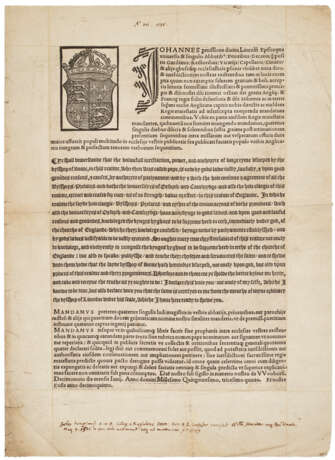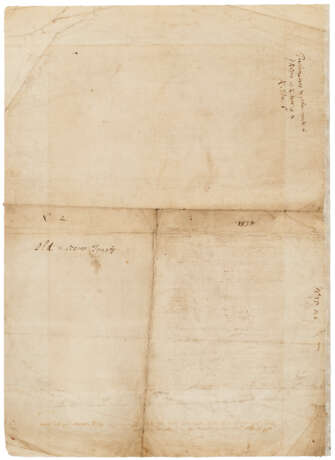ID 1236271
Lot 41 | Mandate asserting the Supremacy of King Henry VIII over the Church
Valeur estimée
$ 100 000 – 150 000
The only surviving example of a highly important broadside issued by Henry VIII’s confessor, calling for the clergy in his diocese to proclaim the king’s supremacy over the Church and uphold the repudiation of the Pope. "Longland's mandate remains the earliest printed example of episcopal support for the royal supremacy" (Wubada).
Pope Clement VII’s refusal to annul the king’s marriage to Catherine of Aragon set Henry on a path toward breaking with the Roman Catholic Church and establishing the Church of England. The Act of Supremacy, which declared Henry to be the "Supreme Head" of the Church and effectively severed ties with the Vatican, was passed in November 1534 and came into force in February 1535. To ensure that the new religious structure was embraced, on 3 June 1535 Thomas Cromwell sent a letter to all bishops in England ordering them to preach in support of the royal supremacy and to enjoin the clergy in their dioceses to do the same.
The present mandate, issued by the Bishop of Lincoln, John Longland, who as the king’s confessor is believed to have been the first to raise with him the possibility of a divorce, followed swiftly on the heels of Cromwell’s instructions. In it, he orders that the proclamation of the king’s supremacy be read in English before as large a congregation as possible on the Sunday or Holy Day immediately following receipt. He gives the form of the English words for the proclamation, orders that all schoolmasters teach their boys the Latin declaration of the King's supremacy, and gives instruction that the word "Pope" is to be erased from all books in churches. A manuscript version of the mandate survives in Longland’s register, and a letter from Longland to Cromwell of 25 June 1535 records that his clerks were working speedily on hand-writing copies of the text for distribution, but also requests approval for a printed version of some two thousand copies to be distributed in order to expedite the process. His request was evidently approved and the printed mandate, of which the present example is the only survivor, was distributed throughout his diocese to form the basis of sermons and to be publicly displayed between services (Wubada, Preaching During the English Reformation). No other mandate issued by a bishop in support of the king’s supremacy is thought to have been printed.
When offered by the booksellers Bernard Quaritch in 1910, the broadside’s printer was tentatively given as Thomas Bertelet, but typographical evidence has since assigned the printing to John Byddell, whose Roman and Gothic types, as well as the large ornamental initial used on the present publication, were inherited from Wynkyn de Worde. ESTC S110987; Wabuda, Susan. "Bishop John Longland's mandate to his Clergy, 1535," The Library, series 6, Vol 13, Issue 3, September 1991, pp.255–261.
Folio broadside (278 x 382mm). Woodcut royal arms and large woodcut opening initial, printed in Roman and Gothic type, visible watermark of a glove and star. The whole cut close and mounted on paper at an early date, with annotations in ink in Latin in an early hand to the outer margins giving the year of publication and biographical information about Longland, and annotations in English to the verso indicating that the broadside was once no.2 in a collection of "Old & scarce tracts" (light wear at old folds including three very tiny interlineal holes and just touching a numeral in the marginal annotations, short closed edge tear, old creases flattened). Provenance: Archbishop John Tillotson (1630-1694; by report) – by direct descent in the Tillotson family, until purchased by: – Bernard Quaritch, bookseller (offered in A Catalogue of Bibles, Liturgies, Church History, and Theology, 1910, no.533; where purchased by:) – Alfred Tredway White, 1846-1921, Brooklyn banker and housing reformer (letter from E.H. Dring, managing director of Quaritch, dated 31 August 1910 and explaining the earlier provenance) – by descent to the present owners.
| Artiste: | John Longland (1473 - 1547) |
|---|---|
| Genre: | Genre religieux |
| Lieu d'origine: | Royaume-Uni |
| Catégorie maison de vente aux enchères: | Livres imprimés |
| Artiste: | John Longland (1473 - 1547) |
|---|---|
| Genre: | Genre religieux |
| Lieu d'origine: | Royaume-Uni |
| Catégorie maison de vente aux enchères: | Livres imprimés |
| Adresse de l'enchère |
CHRISTIE'S 8 King Street, St. James's SW1Y 6QT London Royaume-Uni | |
|---|---|---|
| Aperçu |
| |
| Téléphone | +44 (0)20 7839 9060 | |
| Commission | see on Website | |
| Conditions d'utilisation | Conditions d'utilisation |




